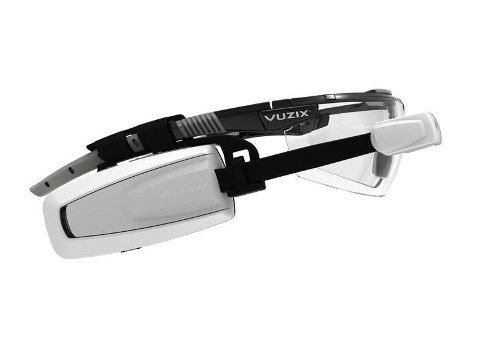
Gear Blink

There have been rumours mounting that Samsung is preparing to bring its own take on Google Glass to the market.
Recent reports from Korea indicate that the South Korean company may unveil its own ‘Gear Glass’ at IFA in September this year, alongside its Galaxy Note Phablet.
Although complete details are not yet available, the high-tech specs may be equipped with the Tizen OS, which the company uses in its latest Galaxy smartwatches.
"The Gear Glass design combines an ear piece and display, enabling people to listen to music with the right ear while looking at the display with the right eye," the Korean publication, Business Korea, alleged.
In the same month, Samsung filed a trademark application for a device known as "Samsung Gear Blink", according to the Guardian, while a patent earlier this year showed a headset that combined an earphone with a heads-up display placed in front of the wearer’s eye.
ARC4

The augmented reality headset allows officers to view and send maps, information and orders to soldiers who can view the data at eye level.
Developed by Applied Research Associates with the US Military’s DARPA unit, the ARC4 system is designed to fit onto a helmet and integrate with weapons control system.
Using the technology, soldiers will also see icons such as map points, friendly forces, vehicles and aircraft overlaid onto their field of vision.
The firm added that its system is more advanced than Google Glass.
"ARC 4 does more than present conventional communications and directional information (e.g., messages, tweets, maps, pictures) in a heads-up fashion.
"ARC4 is transforming your view of the world with digital tags that persist as if painted on physical objects. Imagine it as virtual graffiti."
Moverio BT-200

Epson, best known for printers and projectors, released its Moverio BT-200 smart glasses for less than half the current price of Google Glass in May.
Unlike Glass, Moverio BT-200 has a screen for each eye with 960 x 540 pixels the company claims is the visual equivalent of having an 80-inch TV strapped to your head.
The Moverio lense is double the size of Glass and can be adjusted for prescriptions and sun shading as needed.
Running on Google’s Android 4.0 Ice Cream Sandwich, the $700 device is not wireless but requires the use of a handheld touchpad plugged in with a wire to operate via Wi-Fi or Bluetooth.
Other features include six hours of battery life, Dolby speakers and sensors such as gyroscope, accelerometer and magnetic compass for head tracking and hands-free navigation.
Developers are also working with Epson to create applications for retailers, surgical training for doctors and remote field service support for complex repair assistance.
Vuzix M100

The second generation of the M100 glasses from Vuzix were displayed at this year’s Consumer Electronics Show (CES) in Las Vegas.
The Android-based headset is powered by a 1,2GHz Texas Instruments system-on-chip and connects through Bluetooth or Wi-Fi to smartphones
The $999 device, which incorporates voice recognition and gesture control, can record and playback video, take photos, track timed events and link to a calendar.
Other features include 4GB storage with 32GB SD card support, a WQVGA screen, gyro and proximity sensor, 5MP camera with 1080p recording,
Vuzix claims the device is well suited for a variety of industrial, medical, retail and prosumer applications.
SmartEyeglass

The Japanese company displayed a prototype of the smart glasses at the Mobile World Congress at Barcelona.
The prototype, which has a thicker frame than Google Glass, looks like a pair of sporty sunglasses. Unlike Glass, which has a discreet mini-screen on the top right of the frame, SmartEyeglass uses a binocular see-through display for the lenses, allowing information to directly appear in front of your eye.
Bluetooth and Wi-Fi connections allow for data to be displayed on the lenses, but the device requires an Android device to connect to for information. There’s also a camera on the lenses that you can use to take photos, while other features include an accelerometer, a gyro, a compass, brightness sensors and a microphone.






